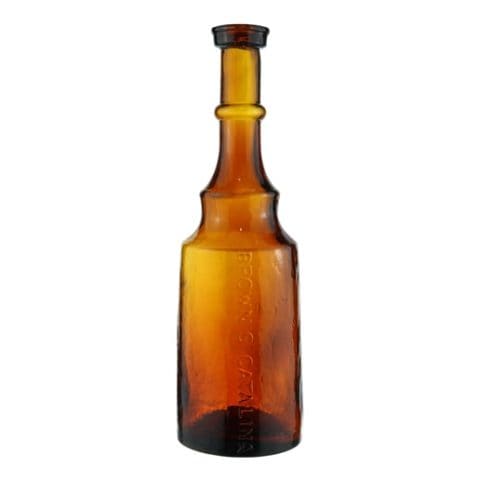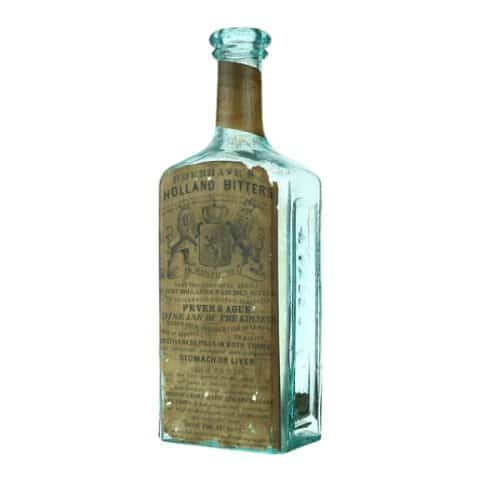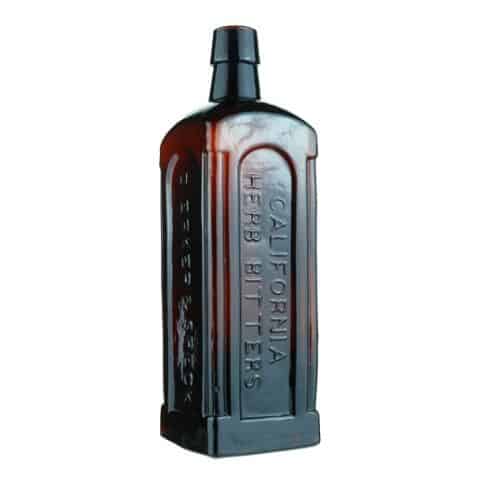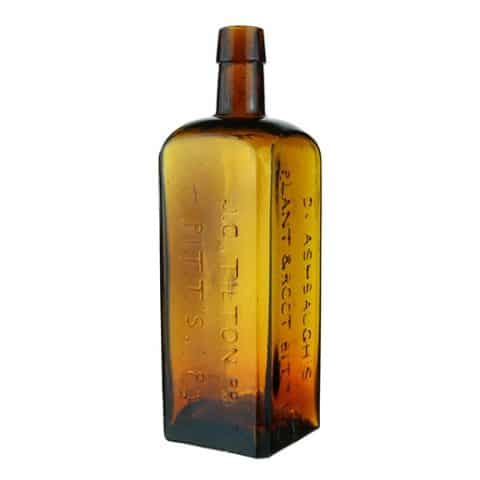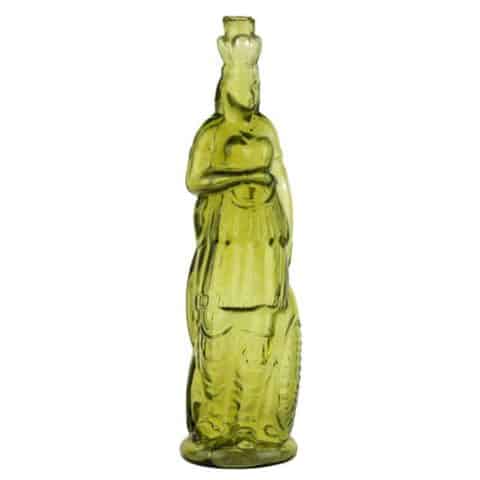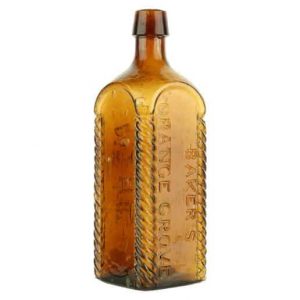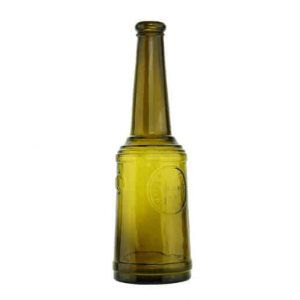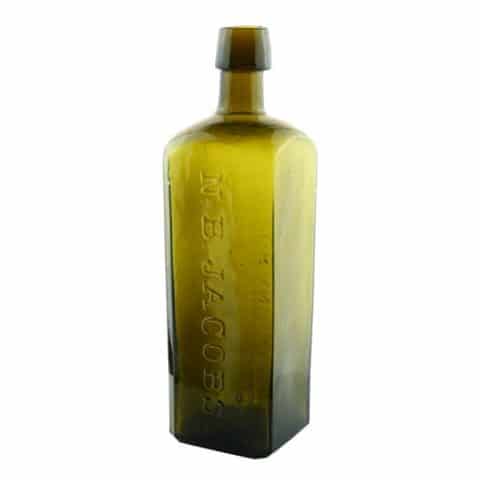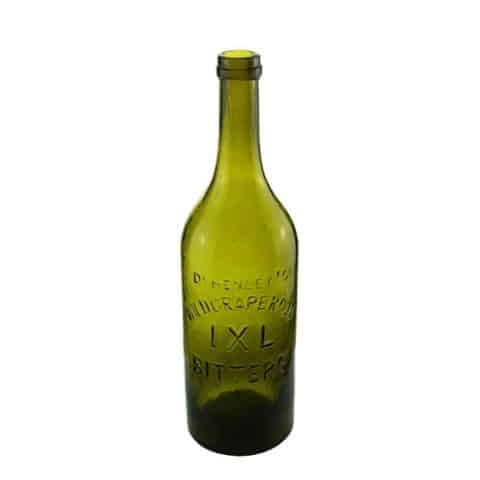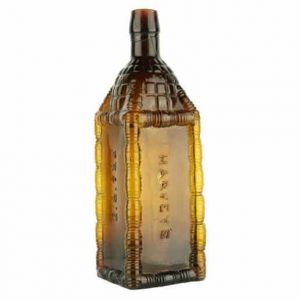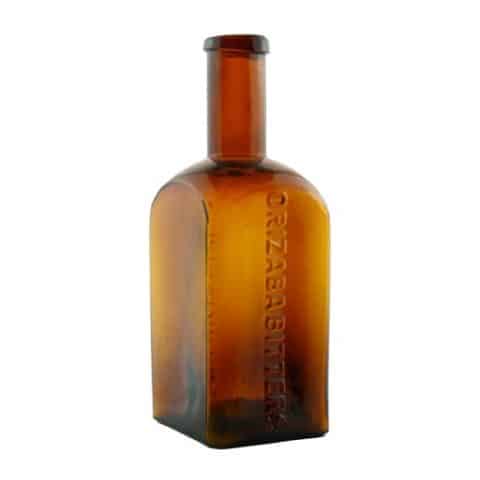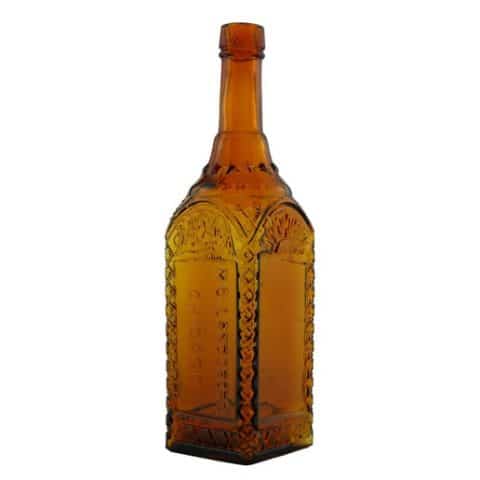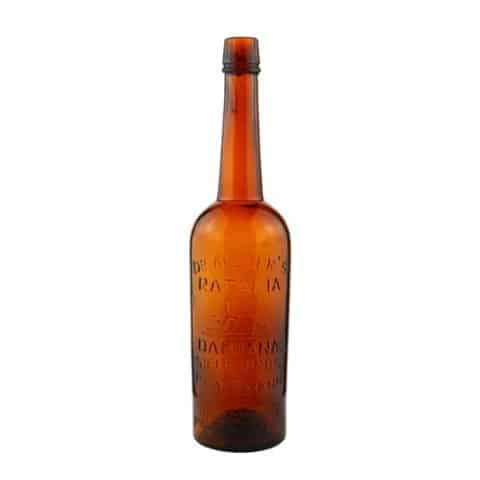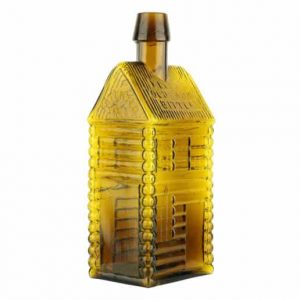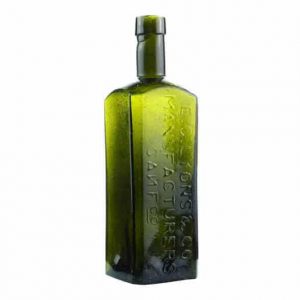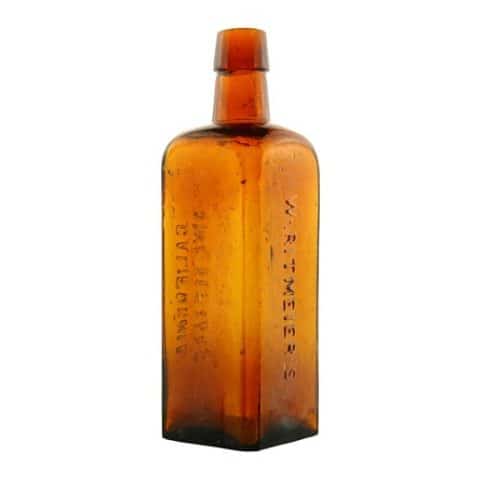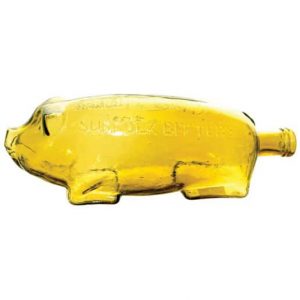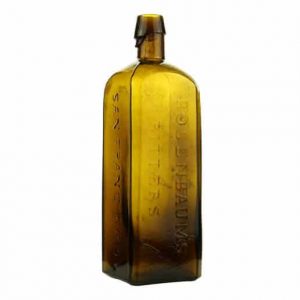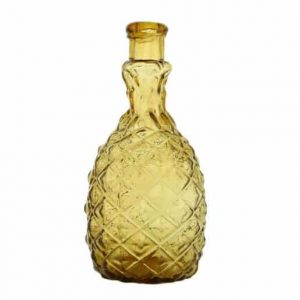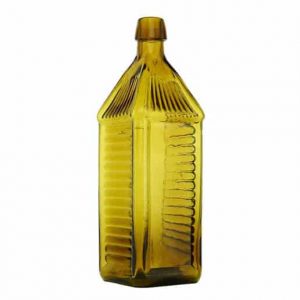The Fish Bitters – Yellow Olive
The Fish Bitters
W. H. Ware
Patented 1866
F 46
Ware & Schmitz, Philadelphia, Pennsylvania
Yellow with Olive Tone Figural
Provenance: Ferdinand Meyer V Collection

Bottle collectors are a little like fishermen when it comes to telling stories. At any get-together of collectors, whether it be at a bottle show, club meeting, or online, you will hear fish tales about the ones that got away, whether it be the broken high dollar bottle found in the last privy dig or a missed opportunity at a recent auction. It seems that someone has always seen a better example but one thing is for sure, fish bottles are keepers.

Fish bottles or flasks are ancient in conception with specimens of glass figures of fish being found as early as 1500 B.C. Given the importance of fish in many cultures, it is not surprising that they would be represented in glass as well as other arts.
In 1922, Eli Lilly & Company began using the blown glass fish bottle for cod liver oil and continued its use until 1933. The bottles were manufactured by the Fairmont Glass Company of Indianapolis. The bottles were produced in four sizes: one pint (10″ long), one-half pint (8 ½″ long), 4 oz (6 ¼″ long) and a salesman bottle (3″ long) which was not filled but used as an empty sample.

The first person to use a fish-shaped bitters bottle was W. H. Ware, who patented a ‘Design for a Bottle’ in December 1866. He used the container for his “Doctor Fisch’s Bitters.” The story is that the bitters recipe was obtained from Dr. Gottlieb Fisch of Berlin, Prussia. Having a doctor’s name associated with your product is always a good marketing idea. Putting your most-likely awful tasting bitters in a fish bottle takes it to the next level of point of purchase sales. A mother doling out doses of fish bitters to her hesitant children from this bottle must have been a little easier than using an aqua or clear glass medicine bottle.

Fish Bitters were advertised in the late 1860s throughout the 1870s for a wide variety of ailments including dyspepsia, general debility, loss of appetite, and as an antidote to alcohol, even though bitters contained large amounts of alcohol itself. Alcohol was the real ‘secret’ with many bitters that purportedly calmed you down and made the children sleep better.

Our subject fish bitters are cataloged in three different molds and can be found in an outstanding range of glass colors such as various shades of amber (golden yellow-amber, tobacco-amber, orange-amber, medium and dark-amber, and reddish-amber) which usually sell in the price range of $300 to $800 depending on the condition of the bottle. The rarer Fish Bitters are those in the colors of aqua, clear, yellow-green, and reddish puce, with the prize of all being cobalt blue.
See the museum example of the cobalt blue Fish Bitters.
The fish bottles are robust and almost 12 inches tall. The paper label was small and thin and was placed on the belly of the fish. The three primary variants are cataloged in Bitters Bottles as F 44 (Doctor Fisch’s Bitters), F 45 (The Fish Bitters with a centered mouth), and F 46 (The Fish Bitters with an off-centered mouth).
The bottles were produced at the Whitney Glass Works is Glassboro, New Jersey.

Read more: The Fish Bitters – Cobalt Blue
Read more: Looking at Dr. Gottlieb Fisch’s Bitters and The Fish Bitters
The Carlyn Ring and W.C. Ham listings in Bitters Bottles is as follows:

F 44 DOCTOR ( ad ) // FISCHS BITTERS ( ad ) // W. H. WARE / PATENTED 1866 //
11 ¾ x 3 5/8 x 2 3/8
Fish, Applied mouth and Rolled Lip, Amber – Common; Aqua, Clear – Very rare
Label: On bevel or stomach a picture of a fish with details in German and English.
Drug Catalogs: 1876-77 and 1880 Goodwin
F 45 THE ( ad ) / FISH BITTERS ( ad ) // W. H. WARE ( ad ) /
PATENTED 1866 ( au ) //
Ware & Schmitz, 3 & 5 Granite Street, Philadelphia, Pennsylvania
11 ½ x 3 5/8 x 2 ½
Fish, Applied mouth and Rolled Lip, Amber – Common; Aqua, Clear, Yellow, Green, Yellow olive, Lime green and Reddish puce – Very Rare; Cobalt – Extremely Rare
Label: Prepared from the recipe of Dr. Gottlieb Fisch of Berlin, Prussia. An unequaled beverage and appetizer invaluable for dyspepsia, general debility, languor, loss of appetite, and any complaint requiring a tonic bitters. Free from the deleterious effects of alcoholic drinks, for which it is an antidote. It is prompt in action, palatable to the taste, and bracing and invigorating in its effects upon both the body and mind.
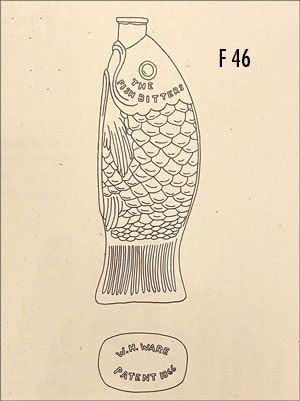
F 46 THE ( ad ) / FISH BITTERS ( ad ) // W. H. WARE ( ad ) /
PATENTED 1866 ( au ) // // b // W. H. WARE / PATENT 1866
Ware & Schmitz 3 & 5 Granite Street Philadelphia, Pennsylvania
11 3/8 x 3 ¾ x 2 ½
Fish, Mouth off-center, Applied mouth, and Rolled Lip, Scales like cobble-stones,
Amber-Scarce; Clear – Rare; Aqua – Extremely rare, Cobalt Blue – Extremely rare
Fish, Mouth off-center, Applied mouth, and Rolled Lip, Scales like cobble-stones, Amber-Scarce; Clear – Rare; Aqua – Extremely rare, Cobalt Blue – Extremely rare
Primary Image: The Fish Bitters bottle imaged by the FOHBC Virtual Museum midwest studio by Alan DeMaison.
Support: Reference to Bitters Bottles by Carlyn Ring and W. C. Ham. Use of Fish Bitters illustrations courtesy Bill Ham.
Support Image: Labeled The Fish Bitters (F 45) with a centered mouth. – Jim Hagenbuch, Glass Works Auctions
Support Images: Images in the sliding carousel from Ed & Kathy Gray, Ted Krist, and Ferdinand Meyer V collections.
Join the FOHBC: The Virtual Museum is a project of the Federation of Historical Bottle Collectors (FOHBC). To become a member.






